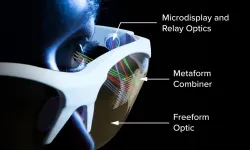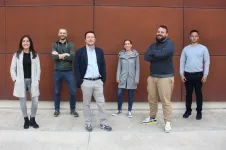(Press-News.org) "Image" is everything in the $20 billion market for AR/VR glasses. Consumers are looking for glasses that are compact and easy to wear, delivering high-quality imagery with socially acceptable optics that don't look like "bug eyes."
University of Rochester researchers at the Institute of Optics have come up with a novel technology to deliver those attributes with maximum effect. In a paper in Science Advances, they describe imprinting freeform optics with a nanophotonic optical element called "a metasurface."
The metasurface is a veritable forest of tiny, silver, nanoscale structures on a thin metallic film that conforms, in this advance, to the freeform shape of the optics--realizing a new optical component the researchers call a metaform.
The metaform is able to defy the conventional laws of reflection, gathering the visible light rays entering an AR/VR eyepiece from all directions, and redirecting them directly into the human eye.
Nick Vamivakas, a professor of quantum optics and quantum physics, likened the nanoscale structures to small-scale radio antennas. "When we actuate the device and illuminate it with the right wavelength, all of these antennas start oscillating, radiating a new light that delivers the image we want downstream."
"Metasurfaces are also called 'flat optics' so writing metasurfaces on freeform optics is creating an entirely new type of optical component," says Jannick Rolland, the Brian J. Thompson Professor of Optical Engineering and director of the Center for Freeform Optics.
Adds Rolland, "This kind of optical component can be applied to any mirrors or lenses, so we are already finding applications in other types of components" such as sensors and mobile cameras.
WHY FREEFORM OPTICS WEREN'T ENOUGH
The first demonstration required many years to complete.
The goal is to direct the visible light entering the AR/VR glasses to the eye. The new device uses a freespace optical combiner to help do that. However, when the combiner is part of freeform optics that curve around the head to conform to an eyeglass format, not all of the light is directed to the eye. Freeform optics alone cannot solve this specific challenge.
That's why the researchers had to leverage a metasurface to build a new optical component.
"Integrating these two technologies, freeform and metasurfaces, understanding how both of them interact with light, and leveraging that to get a good image was a major challenge," says lead author Daniel Nikolov, an optical engineer in Rolland's research group.
THE CHALLENGE OF FABRICATION
Another obstacle was bridging "from macroscale to nanoscale," Rolland says. The actual focusing device measures about 2.5 millimeters across. But even that is 10,000 times larger than the smallest of the nanostructures imprinted on the freeform optic.
"From a design standpoint that meant changing the shape of the freeform lens and distributing the nanostructures on the lens in a way that the two of them work in synergy, so you get an optical device with a good optical performance," Nikolov says.
This required Aaron Bauer, an optical engineer in Rolland's group, to find a way to circumvent the inability to directly specify metasurfaces in optical design software. In fact, different software programs were used to achieve an integrated metaform device.
Fabrication was daunting, Nikolov says. It required using electron-beam lithography, in which beams of electrons were used to cut away sections of the thin-film metasurface where the silver nanostructures needed to be deposited. Writing with electron beams on curved freeform surfaces is atypical and required developing new fabrication processes.
The researchers used a JEOL electron-beam lithography (EBL) machine at the University of Michigan's Lurie Nanofabrication Facility. To write the metasurfaces on a curved freeform optic they first created a 3D map of the freeform surface using a laser-probe measuring system. The 3D map was then programmed into the JEOL machine to specify at what height each of the nanostructures needed to be fabricated.
"We were pushing the capabilities of the machine," Nikolov says. Fei Cheng, a postdoctoral associate in the Vamivakas group; Hitoshi Kato, a JEOL representative from Japan, and the Michigan staff of the nanofabrication lab, collaborated with Nikolov on achieving successful fabrication "after multiple iterations of the process."
"This is a dream come true," Rolland says. "This required integrated teamwork where every contribution was critical to the success of this project."
INFORMATION:
According to Michael Twidale, professor in the School of Information Sciences at the University of Illinois Urbana-Champaign, bad usability can be an irritation for everyone but "especially awful" for the underprivileged. In "Everyone Everywhere: A Distributed and Embedded Paradigm for Usability," which was recently published in the Journal of the Association for Information Science and Technology (JASIST), Twidale and coauthors David M. Nichols (University of Waikato, New Zealand) and Christopher P. Lueg (Bern University of Applied Sciences, Switzerland) present a new paradigm to address the persistence of difficulties that people have ...
(New York, NY) - May 3, 2021 - In advance of a wildfire season projected to be among the worst, the American Thoracic Society has released a report that calls for a unified federal response to wildfires that includes investment in research on smoke exposure and forecasting, health impacts of smoke, evaluation of interventions, and a clear and coordinated communication strategy to protect public health.
The report, Respiratory Impacts of Wildland Fire Smoke: Future Challenges and Policy Opportunities, was published online ahead of print in the Annals of the American Thoracic Society on May 3, 2021.
The report comes at a time when the U.S. is experiencing an increasing frequency of very large destructive wildfires, due to years ...
Over 400 common disinfectants currently in use could be made safer for people and the environment and could better fight the COVID-19 virus with the simple application of UVC light, a new study from the University of Waterloo shows.
Benzalkonium chloride (BAK) is the most common active ingredient in many disinfectants regularly used in hospitals, households, and food processing plants to protect against a wide range of viruses and bacteria - including all strains of SARS-CoV-2, the coronavirus that causes COVID-19 - but its toxicity means that it can't be used in high concentrations. It also means that products containing BAK are harmful to humans ...
LUGANO, Switzerland, 3 May 2021 - As breast cancer becomes a largely curable disease, with more than 70% of women surviving at least 10 years after diagnosis across most of Europe thanks to early detection and treatment, (1) the quality of life after cancer has become an important aspect of the patient journey - one that may be inadequately addressed with current standards of follow-up. A study presented at the ESMO Breast Cancer 2021 Virtual Congress (2) has shown that breast cancer survivors differ widely in the burden of symptoms they experience after the end of treatment and thereby revealed an unmet need for tailored approaches to follow-up care. (3)
Lead author Kelly de Ligt ...
TORONTO - Scientists at the Krembil Brain Institute, part of University Health Network (UHN), in collaboration with colleagues at the Centre for Addiction and Mental Health (CAMH), have used precious and rare access to live human cortical tissue to identify functionally important features that make human neurons unique.
This experimental work is among the first of its kind on live human neurons and one of the largest studies of the diversity of human cortical pyramidal cells to date.
"The goal of this study was to understand what makes human brain cells 'human,' and how human neuron circuitry functions as it does," says Dr. Taufik Valiante, neurosurgeon, scientist at the Krembil Brain Institute at UHN and co-senior author on the paper.
"In our study, we wanted ...
Customised medicines could one day be manufactured to patients' individual needs, with University of East Anglia (UEA) researchers investigating technology to 3D 'print' pills.
The team, including Dr Andy Gleadall and Prof Richard Bibb at Loughborough University, identified a new additive manufacturing method to allow the 3D printing of medicine in highly porous structures, which can be used to regulate the rate of drug release from the medicine to the body when taken orally.
Dr Sheng Qi, a Reader in Pharmaceutics at UEA's School of Pharmacy, led the research. The project findings, 'Effects of porosity on drug release kinetics of swellable and erodible porous pharmaceutical solid dosage forms ...
A research team from the Institut de Neurociències at the Universitat Autònoma de Barcelona (INc-UAB) has showed that inhibition through a drug of the Tac2 neuronal circuit, involved in the formation of the memory of fear, has opposite effects on the ability to remember aversive events in mice according to sex: it is reduced in male mice and increased in female mice.
Is the first time that a drug has been shown to produce this opposite effect on the memory of male and female mice. The study also evidences that opposing molecular mechanisms and behaviours can occur ...
Diatoms are tiny unicellular plants -- no bigger than half a millimeter -- which inhabit the surface water of the world's oceans where sunlight penetration is plenty. Despite their modest size, they are one of the world's most powerful resources for removing carbon dioxide (CO2) from the atmosphere. They currently remove, or "fix," 10-20 billion metric tons of CO2 every year by the process of photosynthesis. But not much is known about which biological mechanisms diatoms use, and whether these processes might become less effective with rising ocean acidity, temperatures, and, in particular, CO2 concentrations. A new study in Frontiers in Plant Science shows that diatoms predominantly ...
New research shows that planned cesarean deliveries on maternal request are safe for low-risk pregnancies and may be associated with a lower risk of adverse delivery outcomes than planned vaginal deliveries. The study is published in CMAJ (Canadian Medical Association Journal).
The study used province-wide data from the Better Outcomes Registry & Network (BORN), Ontario's provincial birth registry. The authors analyzed data on 422,210 low-risk pregnancies over 6 years (2012 to 2018). There were 46,533 cesarean deliveries, of which 1827 (3.9%) were planned at the request of the mother; this proportion was unchanged during the years of study. Mothers who requested cesarean delivery ...
The legacy of systemic racism in the U.S impacts psychosis risk at the individual and neighborhood level, according to a definitive review published online today. Researchers examined U.S. based evidence connecting social and environmental factors with outcomes relating to psychotic experiences, including schizophrenia.
The review examined potential risk factors and influence of structural racism within three key areas. These included disparities in neighborhoods; trauma and stress experienced at both collective and individual levels; and complications experienced around pregnancy.
Disparities in U.S. neighborhoods perpetuate disadvantage for racially minoritized ...



